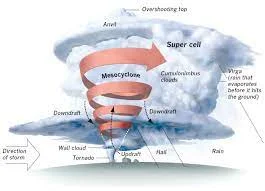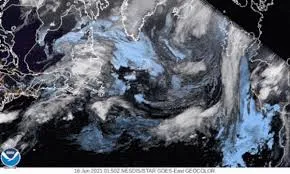Did you know that Hurricanes develop when specific environmental conditions are present, including warm ocean water, high humidity, and favorable atmospheric and upward spiraling wind patterns off the ocean surface?
Did you know that during hurricane season, thunderstorms form over Africa and travel west across the Atlantic, where some develop into tropical cyclones?
Did you know that the Atlantic hurricanes usually start as weak tropical disturbances off the West African coast and intensify into rotating storms with weak winds, called tropical depressions?
Did you know that once the winds exceed 35 miles per hour, the system, now called a "tropical
storm," gets an alphabetical name?
Did you know that a Tropical storm now has the circular structure of a hurricane, although it may not become on?
Did you know that a Tropical Storms are powered by solar heat that was stored in the ocean and then transferred into the warm, moist air?
Did you know that the tropical storm becomes a hurricane once winds exceed 74 miles per hour?
Did you know that Tropical storms that continue to intensify will keep pulling in warm and humid air from the lower atmosphere while spitting out cooler, drier air into the upper atmosphere?
Did you know that in a hurricane development, the storm system operates like a huge "heat engine." The "heat engine" gets its energy from warm, humid air over the tropical ocean and
releases this heat through the condensation of water vapor. This energy release is what drives the powerful winds of a hurricane?
Did you know that the overall development of a hurricane is a complex process that requires a combination of specific environmental conditions?
Did you know that the formation and intensification of hurricanes depend on a range of factors, including ocean temperature, humidity, wind patterns, and atmospheric conditions.?
Did you know that there are 3 stages of hurricane development?
Did you know that the tropical disturbances is the first stage followed closely by tropical depressions, and finishing with tropical storms?
Did you know that the stages of hurricane development include:
Did you know that a Tropical disturbance: This is a cluster of thunderstorms that forms over tropical ocean waters, with no well-defined circulation. These disturbances are the first stage in hurricane development?
Did you know that a Tropical depression: If the disturbance becomes more organized and develops a closed circulation, with sustained winds of up to 38 mph (62 km/h), it is upgraded to a tropical depression?
Did you know that a Tropical storm: If the sustained winds of a tropical depression reach
39-73 mph (63-118 km/h), it is upgraded to a tropical storm. At this stage, the storm is given a name?Did you know that a Hurricane: If the winds of a tropical storm reach 74 mph (119 km/h) or higher, it is upgraded to a hurricane. Hurricanes are classified on a 1-5 scale based on their maximum sustained wind speeds, with Category 5 being the strongest?
As a hurricane develops, it can undergo various changes in intensity and structure. These changes can be influenced by a range of environmental factors, such as sea surface temperatures, wind shear, moisture, and atmospheric stability. Understanding these factors is important for predicting the development and behavior of hurricanes.
- Did you know that a hurricane is a powerful and intense tropical cyclone that forms over warm ocean waters in the Atlantic, Caribbean, or eastern Pacific Ocean?
Did you know that these are some of the characteristics of a hurricane:
Strong winds: A hurricane typically has sustained winds of 74 miles per hour (119 kilometers per hour) or greater. The strongest hurricanes can have wind speeds of 150 miles per hour (241 kilometers per hour) or more.
Eye: A hurricane has a calm, relatively clear center called the eye. The eye is surrounded by a wall of intense thunderstorms called the eyewall.
Heavy rainfall: Hurricanes are known for producing heavy rainfall, which can lead to flooding and landslides.
Storm surge: When a hurricane approaches land, it can cause a storm surge, which is a rise in sea level that can cause flooding in coastal areas.
Tornadoes: Hurricanes can also produce tornadoes, which can cause additional damage.
Large size: Hurricanes can be very large in size, with some covering an area larger than a state.
Duration: A hurricane can last for several days and can travel hundreds of miles over the course of its life cycle.
Did you know that Hurricanes can cause significant damage and destruction, with several destructive elements associated with them?
Did you know that some of the most devastating elements of a hurricane include:
Storm surges: This is the abnormal rise in water level that is caused by a hurricane's winds and low atmospheric pressure. Storm surges can lead to massive flooding, and can be extremely dangerous as they can reach heights of 20 feet or more. They can cause significant damage to buildings, homes, and other infrastructure, and can lead to loss of life.
High winds: Hurricanes can produce extremely high winds, with speeds that can exceed 100 miles per hour. These winds can uproot trees, damage buildings and infrastructure, and even cause vehicles to be thrown around. The high winds can also cause power outages, making it difficult for emergency services to respond to the storm's impact.
Heavy rainfall and flooding: Hurricanes can produce heavy rainfall, which can lead to widespread flooding. The flooding can damage homes and infrastructure, and can cause significant economic losses. In some cases, heavy rainfall can also lead to landslides and mudslides.
Tornadoes: Hurricanes can also produce tornadoes, which can cause significant damage to homes and infrastructure. Tornadoes associated with hurricanes tend to be short-lived, but they can be very powerful and can cause significant damage.
Did you know that Hurricanes are rated based on their wind speed and potential for damage using the Saffir-Simpson Hurricane Wind Scale. This scale categorizes hurricanes into five categories based on their sustained wind speeds, with Category 1 being the weakest and Category 5 being the strongest.?
Did you know that hurricanes categories are as follows:
- Category 1: 74-95 mph (119-153 km/h) winds. Very dangerous winds that will produce some damage.
- Category 2: 96-110 mph (154-177 km/h) winds. Extremely dangerous winds that will cause extensive damage.
- Category 3: 111-129 mph (178-208 km/h) winds. Devastating damage will occur.
- Category 4: 130-156 mph (209-251 km/h) winds. Catastrophic damage will occur.
- Category 5: 157 mph (252 km/h) or higher winds. Catastrophic damage will occur.
Did you know that in addition to wind speed, the scale also takes into account the potential for storm surge and flooding, which can cause significant damage and loss of life even in weaker hurricanes?

Now if you didn't know, now you know...
To see more did you know that trivia click here




















